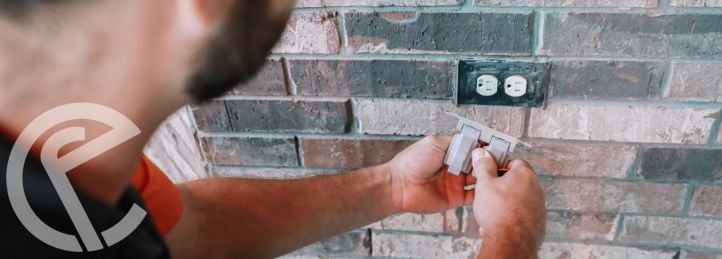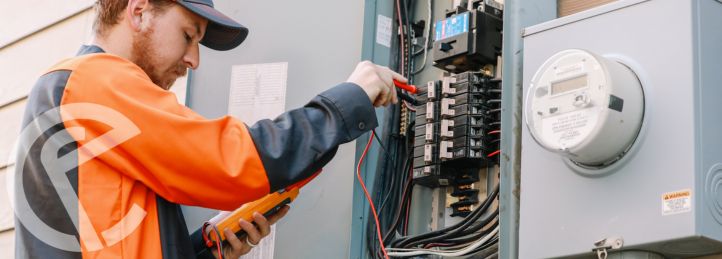Electrical Services in San Antonio, TX

From safe installations to emergency repairs, electrical work demands expertise and precision. At Evenflow Home & Commercial Services, we offer licensed, dependable electrical services for homes and small businesses across San Antonio. Our faith-based, customer-focused approach means your satisfaction is our highest priority.
- We Are Locally Owned and Operated: With deep roots in the San Antonio community, we bring local insight and personalized service to every job. You’re not just another appointment, you’re our neighbor.
- 100% Satisfaction Guarantee: We back every project with our commitment to excellence. If you’re not fully satisfied, we’ll do everything it takes to make it right, no matter how big or small the issue.
- Focused on Superior Customer Support: From your first phone call to the final walkthrough, we prioritize clear communication, professional courtesy, and on-time service.
No matter your electrical need, from troubleshooting to panel upgrades, you can trust our team for safety, code compliance, and reliable power.
Where your service flows smoothly from start to finish: we guarantee it. Choose Evenflow Home & Commercial Services for expert electrical services that put your family first.

Why San Antonio Homeowners Choose Evenflow Home & Commercial Services for Electrical Work
Our electricians are licensed, insured, and up-to-date on the latest codes and technologies. Whether it’s a ceiling fan install or a full rewiring project, we handle every task with care.
Reputation You Can Rely On
- Voted Top Service Company on Home Advisor: This recognition reflects our consistent record of punctual appointments, excellent workmanship, and positive customer feedback.
- Rated "A" by the Better Business Bureau: Our high BBB rating shows our longstanding commitment to ethical business practices and customer satisfaction.
- Faith-Based Commitment to Integrity: We operate on principles of honesty, transparency, and respect, values that guide every interaction and service we deliver.
Full-Service Electrical Capabilities
We provide a wide range of services tailored to meet the needs of homeowners and light commercial clients:
- Electrical Panel Upgrades: We replace outdated fuse boxes or undersized panels with modern circuit breaker systems that support current and future power needs, reducing fire risk and frequent breaker trips.
- Lighting Installation: From ambient recessed lighting to dramatic chandeliers and efficient LED systems, we install and wire all types of indoor and outdoor lighting with safe, code-compliant connections.
- Outlet and Switch Upgrades: We install GFCI outlets in kitchens and bathrooms, add USB-equipped outlets for charging convenience, and upgrade light switches to smart or dimmer models to boost functionality.
- Home Rewiring: Older homes with outdated or unsafe wiring (such as aluminum or knob-and-tube) benefit from full rewiring for safety, capacity, and code compliance.
- Surge Protection: Whole-home surge protectors safeguard your electronics and HVAC systems from power spikes caused by storms, outages, or grid fluctuations.
- Generator Installation: We assess your power needs, recommend the right standby or portable generator, and provide seamless installation and panel integration for emergency readiness.
- Code Corrections and Inspections: Whether you’re selling your home or completing a renovation, we inspect existing wiring, correct noncompliant setups, and bring your system up to San Antonio code standards.
Transparent, Ethical, and Efficient Service
We make it easy to understand your options and stay in control:
- Clear, Itemized Estimates: You receive a detailed, upfront quote listing all materials and labor costs, so there are no surprises at the end of the job.
- Respect for Your Home: We use drop cloths, wear protective footwear, and clean up thoroughly before we leave, treating your home as if it were our own.
- Satisfaction Guaranteed: If something isn’t right, we’ll correct it quickly and professionally, with no hassle and no added fees.
Need fast, reliable help with an electrical issue? Contact Evenflow Home & Commercial Services today for a quote or service appointment.
Power Up With Confidence
A safe and modern electrical system improves your daily comfort and your home’s long-term value. Let our licensed team provide expert solutions tailored to your needs.
Schedule your electrical service with Evenflow Home & Commercial Services today and experience service powered by integrity.
Common Electrical Problems in San Antonio Homes
Electrical issues can be frustrating and dangerous. At Evenflow Home & Commercial Services, we’ve seen firsthand how aging infrastructure, storm surges, or improper DIY work can compromise a home’s safety and functionality. That’s why we offer fast, expert diagnostics and repairs across San Antonio.
Frequent Electrical Issues We Resolve
- Circuit Breaker Trips: Often caused by overloaded circuits, outdated panels, or short circuits, repeated breaker trips may signal an urgent safety concern.
- Flickering or Dimming Lights: Loose wiring, corroded connections, or excessive load on one circuit can cause lights to dim or flicker unexpectedly.
- Non-Functioning Outlets or Switches: Dead outlets or switches often result from worn wiring, tripped GFCIs, or internal short circuits and should be evaluated immediately.
- Burning Odors or Warm Switch Plates: Any sign of heat or burning smells from your electrical system must be inspected for fire risk.
- Buzzing Noises or Arcing: Sounds from outlets or panels often indicate a serious wiring issue or damaged breaker that needs immediate repair.
- Power Surges: Repeated surges can originate from faulty appliances or utility grid issues and may damage electronics and reduce appliance lifespan.
- Outdated Wiring: Homes with aluminum, knob-and-tube, or cloth-insulated wiring may no longer meet code or safety standards and should be upgraded.
If you’ve noticed any of these symptoms in your home, call Evenflow Home & Commercial Services today. We’ll diagnose the root cause and offer safe, code-compliant solutions.
Don’t wait for a dangerous failure! Get expert electrical troubleshooting from San Antonio’s trusted team.
Key Electrical System Components in Your Home
Understanding your home’s electrical system can help you better maintain it and recognize when something needs service. Here’s a breakdown of the major components:
- Electrical Service Panel (Breaker Box): This is the hub for your home’s electricity, distributing power to circuits and protecting against overloads. Outdated panels may be undersized or unsafe.
- Wiring: Copper or aluminum wiring carries power throughout your home. Modern code requires properly insulated copper wires for most residential use.
- Outlets and Switches: Essential access points for electricity, outlets and switches can degrade over time and may require GFCI or AFCI upgrades for added protection.
- Grounding System: Directs excess electrical current safely into the earth to prevent shocks or fires. A compromised ground system increases the risk of damage during surges.
- Lighting Fixtures: From ceiling fans to recessed lights, each fixture should be wired correctly and securely mounted.
- Dedicated Circuits: Appliances like ovens, dryers, and HVAC units require individual circuits to handle their higher electrical loads.
- Smoke and Carbon Monoxide Detectors: These essential safety devices must be hardwired and tested regularly for proper function.
At Evenflow Home & Commercial Services, we inspect, service, and upgrade all critical components to keep your system safe, reliable, and up to code.
Stay ahead of costly outages and risks with expert help from your San Antonio electrical team.

Reliable Electrical Services for San Antonio Homes
Your home’s electrical system is the foundation of modern living. Whether you’re installing new lighting, upgrading panels, or addressing an unexpected power outage, Evenflow Home & Commercial Services delivers trusted solutions with licensed expertise and unmatched customer care. Every service is performed with integrity, safety, and precision.
Electrical Installation
When to Consider
If you’re building an addition, remodeling your kitchen, or adding new appliances or smart technology, you’ll need professional electrical installation to ensure safe, efficient power distribution.
Why It’s Important
Proper installation ensures your system meets code, reduces the risk of shock or fire, and supports the performance of your devices and appliances. It also increases energy efficiency and long-term reliability.
What’s Included
- On-site consultation and system design: We evaluate your home’s current electrical load, planned upgrades, and future needs to create a tailored electrical plan that optimizes safety and performance.
- New wiring and outlet installation: Our team installs copper wiring, grounded outlets, and properly rated circuit breakers to handle everyday use and surge protection with maximum reliability.
- Lighting setup and fixture installation: We professionally mount and wire ceiling fans, recessed lighting, chandeliers, sconces, smart lighting systems, and outdoor security lights, ensuring optimal brightness and placement.
- Appliance and EV charger circuits: Dedicated wiring is provided for high-draw appliances like ovens, washers, dryers, and hot tubs, along with safe installation of EV charging stations compatible with leading car brands.
- Permits and code compliance: We handle all municipal permitting, schedule inspections, and ensure installations follow NEC and San Antonio codes to avoid future fines or hazards.
Trust our expert electricians to power your home with precision and care.
Electrical Repair
When to Consider
Experiencing flickering lights, dead outlets, or unusual breaker trips? These are signs your electrical system needs immediate attention.
Why It’s Important
Timely repairs reduce the risk of fire, appliance damage, and costly outages. Even minor issues can indicate major system weaknesses.
What’s Included
- Full diagnostic service: Using thermal cameras, multimeters, and circuit tracers, we pinpoint the source of faults, surges, or worn components to stop problems at their root.
- Component replacement: Our team replaces damaged or outdated outlets, light switches, GFCIs, receptacles, and wiring with new, UL-listed components designed for performance and safety.
- Panel troubleshooting: We check for double-tapped breakers, signs of overheating, rust, loose connections, and incompatible circuits that may lead to fire or failure.
- Code correction repairs: If your system fails an inspection or has DIY shortcuts, we bring your wiring, grounding, and breaker systems back into safe, up-to-code condition.
- Fast, courteous service: Most repair jobs are completed on the same day with minimal interruption. We arrive fully equipped and clean up before leaving.
Let Evenflow Home & Commercial Services restore safe, reliable power to your home.
Electrical Safety Upgrades
When to Consider
If your home is more than 20 years old, or you’ve never had a comprehensive inspection, it may be time for critical safety upgrades.
Why It’s Important
Modern devices and energy loads often exceed the capabilities of older systems. Upgrades protect your family and investment while reducing liability and improving efficiency.
What’s Included
- Electrical panel upgrades: We replace outdated panels with high-capacity units that support current and future electrical demands, including smart home technology and solar system tie-ins.
- Whole-home surge protection: Installed at your main panel, these devices absorb sudden voltage spikes caused by lightning or grid issues, shielding appliances and electronics from damage.
- GFCI/AFCI outlet replacement: Our electricians upgrade vulnerable zones with safety outlets that reduce shock and fire risks by instantly cutting power during dangerous ground or arc faults.
- Smoke and CO detector upgrades: We install interconnected alarms in key areas of your home and test for proper wiring and battery backup to ensure early-warning protection.
- Grounding system checks: We verify the presence of properly bonded grounding rods, jumpers, and water pipe connections to eliminate stray voltage and reduce surge risks.
Whether it’s a fresh install, fast repair, or safety upgrade, Evenflow Home & Commercial Services is your local expert for dependable electrical work in San Antonio.
Book your appointment today and power your home with peace of mind.
